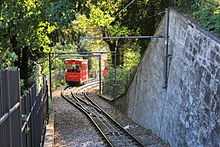Polybahn funicular
| Polybahn | |
|---|---|
 | |
| Operation | |
| Opening | 1889 |
| Owner | UBS AG |
| Operator(s) | Verkehrsbetriebe Zürich |
| Technical | |
| Track length | 176 metres (577 ft) |
| Track gauge | 955 mm (3 ft 1 19⁄32 in) |





The Polybahn, also known as the UBS Polybahn, is a funicular railway in the centre of the city of Zürich, Switzerland. Previous names for the line include the SBG Polybahn and the Zürichbergbahn. The line is owned by the banking group UBS AG, and operated on their behalf by the municipal transport operator Verkehrsbetriebe Zürich.[1][2][3][4]
The line operates out of Zürich Central-Hochschulen, and carries passengers up to the terrace by the main building of ETH Zürich, which was formerly called Eidgenössisches Polytechnikum, and from which the railway derives its name.
The Polybahn is one of two funiculars within the city of Zürich, the other being the Rigiblick funicular in the city's northern suburbs. Additionally, the city's Dolderbahn rack railway was originally a funicular, until its conversion to rack working in the 1970s.
History
In 1886 a concession for the railway was issued, and the line was opened by the Zürichbergbahn company in 1889. The funicular was initially water-driven (filling water in a ballast tank under the carriage at the top station, emptying at the bottom); the railway was converted to electric drive in 1897.[5]
In 1950 the Zürichbergbahn company began losing money, and eventually (in the 1970s) decided not to renew the concession. In 1972 a foundation was created to help preserve the Polybahn. In 1976 the Union Bank of Switzerland, then known in German as the Schweizerische Bankgesellschaft or SBG, rescued the Polybahn, branding it as the SBG Polybahn. The line and cars were refurbished for a planned 20 more years service.[5]
In 1996 the railway was completely rebuilt. The haulage mechanism was replaced, and fully automated, whilst the old three-rail tracks were replaced with the current two-rail tracks. On 21 October 1996 the railway reopened and is now advertised under the name UBS Polybahn, reflecting the rebranding (in 1998) of the owning banking group as UBS AG. In 1998 the line set a new record, carrying more than 2 million passengers.[5]
Operation
The line has the following parameters:[3][4][1]
| Number of cars | 2 |
| Number of stops | 2 |
| Configuration | Single track with passing loop |
| Mode of operation | Automated |
| Drive | Three-phase AC motor with frequency changer |
| Track length | 176 metres (577 ft) |
| Rise | 41 metres (135 ft) |
| Average gradient | 23% |
| Track gauge | 955 mm (3 ft 1 19⁄32 in) |
| Capacity | 50 persons per car |
| Maximum speed | 2.5 metres per second (8.2 ft/s) |
| Capacity per direction | 1200 Persons/hour |
| Travel time | 100 seconds |
| Frequency | Every 2.5 minutes |
The standard Zürcher Verkehrsverbund zonal fare tariffs apply, with the whole of the line being within fare zone 110 (formerly zone 10) (Zürich city).[6] However, there is a special flat tariff only applicable to Polybahn for CHF 1.20 per ride.
See also
References
- ↑ 1.0 1.1 "UBS Polybahn" (in German). VBZ. Retrieved 2011-08-09.
- ↑ "Zürich - Polybahn". Lift-World.info. Retrieved 2011-08-09.
- ↑ 3.0 3.1 "Polybahn". Funiculars.net. Pantograph.se. Retrieved 2011-08-09.
- ↑ 4.0 4.1 Eisenbahnatlas Schweiz. Verlag Schweers + Wall GmbH. 2012. p. 65. ISBN 978-3-89494-130-7.
- ↑ 5.0 5.1 5.2 "Geschichte der UBS Polybahn" [History of the UBS Polybahn] (in German). VBZ. Retrieved 2011-08-09.
- ↑ "Frequently asked questions". Zürcher Verkehrsverbund. Retrieved 2011-08-26.
External links
-
 Media related to Polybahn at Wikimedia Commons
Media related to Polybahn at Wikimedia Commons - Page on the Polybahn from the official web site of the VBZ (in German)
- Funimag article on the Polybahn
- Video of descent of the line from YouTube
Coordinates: 47°22′35″N 8°32′38″E / 47.37639°N 8.54389°E